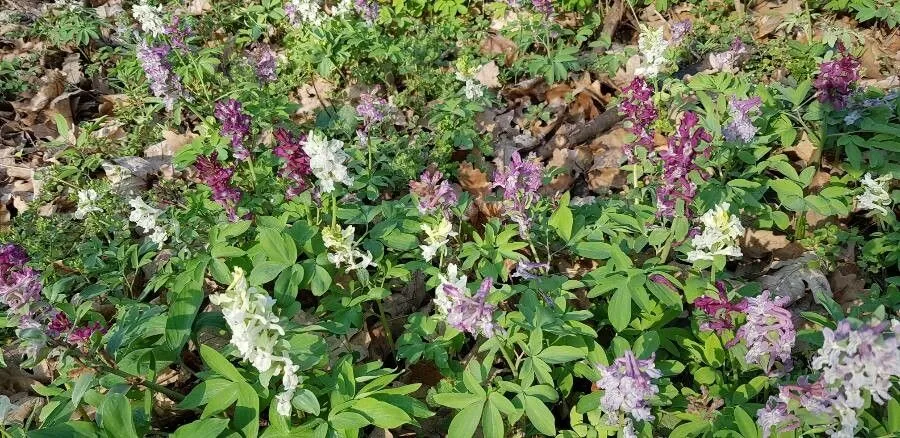
Author: (L.) Schweigg. & Körte
Bibliography: Fl. Erlang. 2: 44 (1811)
Year: 1811
Status: accepted
Rank: species
Genus: Corydalis
Vegetable: False
Observations: Europe to Caucasus
Hollowroot, scientifically known as Corydalis cava, is a captivating flowering plant renowned for its enchanting aesthetic and delicate blossoms. This plant belongs to the Papaveraceae family, a diverse family of flowering plants commonly known for their vibrant and often ornate flowers.
Native to a broad geographic range, Hollowroot can be found stretching from Europe, extending through Eastern regions to the Caucasus. This distribution highlights its adaptability and the plant’s ability to thrive in various climatological conditions across these regions.
The plant typically flourishes in shaded woodland areas, where it contributes to the understorey with its attractive and distinctive flowers. Hollowroot’s appearance is characterized by its tube-like roots – a unique feature that gives rise to its common name. The foliage consists of finely divided, lacy leaves that accompany clusters of tubular flowers. These flowers are usually seen in early spring, displaying hues ranging from white to purple, and often possess a delicate fragrance that attracts pollinators such as bees and butterflies.
Corydalis cava holds a historic botanical significance and was first documented in 1811 in the literature “Flora Erlangensis.” The plant has been subject to various botanical studies over the centuries, attributed to its unique physical characteristics and its prevalence across a wide range of habitats.
Despite its delicate appearance, the Hollowroot is a resilient species, withstanding the rigours of early spring weather to bring vibrant color to woodlands and gardens. Its intricate blooms and lush foliage make it an appealing choice for naturalistic landscaping and wildflower gardens, adding both ecological value and aesthetic appeal to cultivated areas.
Overall, Hollowroot is a testament to the diverse beauty and adaptability of the Papaveraceae family, contributing significantly to the floral biodiversity of the regions it inhabits.
Deu: hohler lerchensporn, hohlknollige lerchensporn
Eng: hollowroot, hollow root
Dan: hulrodet lærkespore
Fra: corydale creuse
Lav: dobais cirulitis
Nld: holwortel
Swe: hålnunneört, skånsk nunneört
Nno: hollerkespore
Nob: hullerkespore
Cym: corydalis gwagwraidd, gwagwraidd
En: Hollowroot, Hollow Root
Da: Hulrodet lærkespore
Nl: Holwortel
Fr: Corydale creuse, Corydale à tubercule creux, Fumeterre creuse, Corydale à bulbe creux, Corydale bulbeuse
De: Hohler Lerchensporn, Hohlknollige Lerchensporn, Hohlknolliger Lerchensporn
It: Colombina cava
Lv: Dobais cirulitis
Nb: Hullerkespore
Nn: Hollerkespore
Es: Aristoloquia hueca, Violeta pequeña
Sv: Hålnunneört, Skånsk nunneört
Cy: Corydalis Gwagwraidd, Gwagwraidd
© copyright of the Board of Trustees of the Royal Botanic Gardens, Kew.
© copyright of the Board of Trustees of the Royal Botanic Gardens, Kew.
© copyright of the Board of Trustees of the Royal Botanic Gardens, Kew.
Taken Apr 2, 2021 by Marcin (cc-by-sa)
Taken Apr 19, 2022 by manuseitz (cc-by-sa)
Taken Apr 19, 2022 by manuseitz (cc-by-sa)
Taken Apr 11, 2022 by manuseitz (cc-by-sa)
Taken Apr 19, 2022 by manuseitz (cc-by-sa)
Taken Mar 28, 2022 by Danilo Brugali (cc-by-sa)
Taken Mar 28, 2022 by Danilo Brugali (cc-by-sa)
Taken Apr 9, 2018 by Dieter Wagner (cc-by-sa)
Taken Apr 8, 2018 by Bastien Zanette (cc-by-sa)
Taken Apr 7, 2018 by Dieter Wagner (cc-by-sa)
Taken Apr 13, 2021 by Błażej Nowak (cc-by-sa)
Taken Mar 24, 2022 by Ulrike Berner (cc-by-sa)
Taken Mar 19, 2020 by Sabina Hartmann (cc-by-sa)
Taken Mar 26, 2022 by Kai Best (cc-by-sa)
Taken Mar 28, 2022 by Danilo Brugali (cc-by-sa)
Taken Mar 26, 2022 by Kai Best (cc-by-sa)
Taken Mar 30, 2022 by Radu Nicolau (cc-by-sa)
Taken May 9, 2021 by Judit Simon (cc-by-sa)
Taken Apr 29, 2022 by Frédéric Baylac-Domengetroy (cc-by-sa)
Taken Mar 19, 2020 by Sabina Hartmann (cc-by-sa)
Taken Mar 15, 2013 by Photoflora – Benoit BOCK (©)
Taken Mar 18, 2020 by bodlak2010 (cc-by-sa)
Taken Apr 2, 2018 by giulia (cc-by-sa)
Taken Mar 18, 2021 by mohammad fazel dehkordi (cc-by-sa)
Taken Apr 11, 2022 by manuseitz (cc-by-sa)
Taken Mar 10, 2022 by Else Nolden (cc-by-sa)
Taken Apr 2, 2021 by Jiří Kubeš (cc-by-sa)
Taken Mar 27, 2021 by An Van Brusselt (cc-by-sa)
Taken Apr 25, 2021 by Hana Renickova (cc-by-sa)
Taken Mar 28, 2022 by manuseitz (cc-by-sa)
Ph maximum: 7.5
Ph minimum: 7.0
Light: 4
Atmospheric humidity: 8
Bloom months: [‘apr’, ‘may’]
Soil nutriments: 6
Family: Myrtaceae Author: (F.Muell.) K.D.Hill & L.A.S.Johnson Bibliography: Telopea 6: 402 (1995) Year: 1995 Status:…
Family: Rubiaceae Author: Pierre ex A.Froehner Bibliography: Notizbl. Bot. Gart. Berlin-Dahlem 1: 237 (1897) Year:…
Family: Sapindaceae Author: Koidz. Bibliography: J. Coll. Sci. Imp. Univ. Tokyo 32(1): 38 (1911) Year:…
Family: Asteraceae Author: A.Gray Bibliography: Pacif. Railr. Rep.: 107 (1857) Year: 1857 Status: accepted Rank:…
Family: Fabaceae Author: Medik. Bibliography: Vorles. Churpfälz. Phys.-Ökon. Ges. 2: 398 (1787) Year: 1787 Status:…
Family: Aspleniaceae Author: (Cav.) Alston Bibliography: Bull. Misc. Inform. Kew 1932: 309 (1932) Year: 1932…